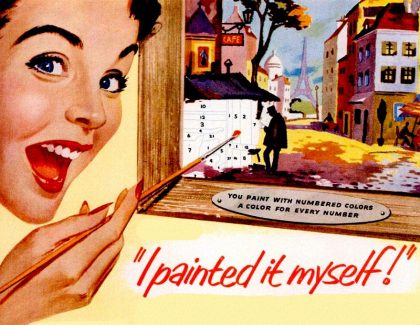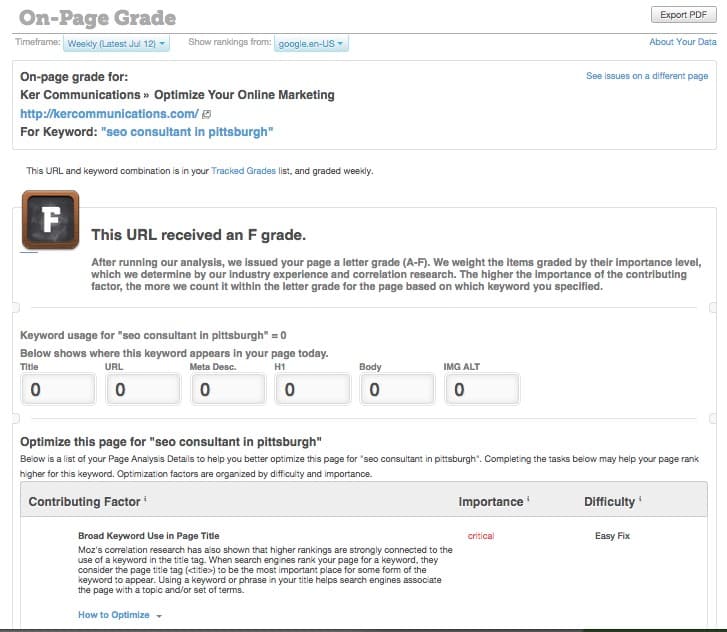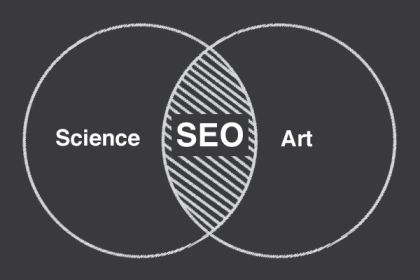If you do these 15 simple things, your website will show up at the top of the Google search results…
No, it won’t. It probably won’t if you do 50 simple things, either.
 The truth is, there is no easy way to quickly get to the top of organic Google search results and stay there indefinitely. Yet I speak with otherwise business-smart, tech-savvy people every day who ask, “How can I get my page to rank number one?” And they expect a simple answer.
The truth is, there is no easy way to quickly get to the top of organic Google search results and stay there indefinitely. Yet I speak with otherwise business-smart, tech-savvy people every day who ask, “How can I get my page to rank number one?” And they expect a simple answer.
If it was that easy, I’d write a very short book explaining it all, rather than putting in countless hours optimizing websites, crafting useful content, and doing all the PR leg work to make people aware of amazing websites full of great content.
Even people who understand that the simple SEO tricks of the past no longer work, and that online marketing is much more challenging than ever – still want simple solutions. That’s human nature, I guess. It also seems to be human nature to believe that everything that is done with computers or the internet, including SEO, is “just numbers” – the number of links to your site, how frequently a keyword is used, how many words should be in a blog post, the number of words in a title… It leads to a “paint by numbers” approach to optimization. If you remember doing paint-by-numbers “art” as a child, you may recall that it was fun to color in the spaces and eventually see the full picture. That picture may have even been nice enough that Mom hung it on the refrigerator. But it was not really art.
The Problem with Paint-by-Numbers SEO Checklists
 SEO “do it yourselfers” and many professional SEOs often use “best practices” checklists of things they believe absolutely must be in place in order to rank well in the search results. The thing is, many of the things on the checklists are wrong – based on outdated information, unproven theories that are mindlessly repeated, or things that may work for some other site but not yours.
SEO “do it yourselfers” and many professional SEOs often use “best practices” checklists of things they believe absolutely must be in place in order to rank well in the search results. The thing is, many of the things on the checklists are wrong – based on outdated information, unproven theories that are mindlessly repeated, or things that may work for some other site but not yours.
The most basic things really should be in a checklist – make sure the site is up and running, it isn’t blocking Google via robots.txt, each page has a unique title and content, that there are no broken links to other pages within your site… But most of the things that really do something to make a difference require some thought and ingenuity. Creativity.
An unlikely example…
One of the most respected tool sets in SEO is Moz Pro from Moz.com. One of its main features is the grading of On Page Optimization. It gives a letter grade to a page in regard to how well the page is optimized for a given keyword. It runs a checklist of most of the things that SEOs commonly consider to be important – keyword usage, H1s, alt tags, where the keyword appears in the title and so on. It really is a useful SEO tool, something that is increasingly rare. The folks at Moz clearly know SEO, but if you were to follow only that checklist, or the common wisdom upon which it seems to be based – the results may confuse you. This is not meant to be a dig at Moz or its page grading tool. It is a great starting point for on page optimization. But every starting point should have somewhere for you to go after that. Being able to figure out where to go from there is what sets good SEO apart from the masses of “I did everything I was supposed to do” sites that don’t do well in search.
Many times, the Moz grader will score a page with an A grade for a keyword – yet it does not even come close to ranking on page one. The opposite is also often true. If one of the most popular online SEO tools can be so wrong, you are going to need a better one. The most effective SEO tool you need to use is a creative mind, powered by common sense and ingenuity.
High Rankings with No Keywords in the Title… or on the page!
The home page of KerCommunications.com ranks well for a bunch of different search terms. The last time I checked with Moz’s grader, the home page of this site receives an “F” grade for nearly everything for which it ranks number one. That’s right – I colored outside the lines, page ranks number one (or at least in the top 3 or 4), but the teachers gave me an F for not doing it their way.
It is easy to make assumptions about certain things just because they have “always been”. But there are few absolutes. For example, “you must have your keyword at the beginning the title tag” in order for the page to rank well. That’s not always necessary. As a matter of fact, you don’t even need the exact keyword on the page anymore…
For example, let’s look at the basics for “SEO consultant in Pittsburgh”.


That exact phrase does not appear on the page. “Pittsburgh” is only used on the page one time in addition to the address in the footer, and none of the keywords appear in the title tag of the home page – unlike all those “Pittsburgh SEO and Inbound Marketing Pittsburgh SEO Company in Pittsburgh” sites out there. Consultant is on the page somewhere, and SEO is probably used too much. Nailed it in regard to having enough words on the page, and nothing is broken; but otherwise the home page fails the grading checklist. The biggest “fails” being that the keyphrase does not appear in the title at all, and the exact phrase does not appear on the page at all.
Yes, all of those words that make up the keyphrase do appear somewhere on the page, but it certainly does not look like anyone worked very hard at ranking for that phrase. Some people thought it was bullshit when some of us in the SEO industry started talking about semantic search and topical optimization, but this is a fine example.
As competitive as SEO is, and given the way SEOs use “(City Name) SEO” as a trophy keyword to demonstrate how good they supposedly are – wouldn’t you think sites that follow the usual best practices of paint-by-numbers SEO would consistently rank above Ker Communications? They usually don’t.
How do we do that?
By now you may be thinking “Nick Ker is a complete nutcase! He doesn’t even use keywords! Now he’s going to give away the secret sauce!” No worries here. I could say exactly how it was/is done for KerCommunications.com, but it probably won’t make a difference and here’s why:
SEO is not paint-by-numbers. It is not a checklist of things that when done properly will guarantee a top spot in the search results. Many of the things that work for this site probably won’t work for yours. All kinds of recommendations about SEO can be found online, but how do you know what really works? How can you tell if you did it right?
What sets me or any good optimizer apart from the crowd is experience, the ability to discover what will work for your site, and the know-how do it correctly.
 SEO is an “art” as well as a “science”. I would even argue that it is more art than science, these days. That is why many do not succeed with SEO – they view it only as a science. They think “it’s all about links/keywords/lots of content” or “it is all about code… some magical code that I just need to find out what it is and add it to my site”. Yes, links, keywords, content and code are all important – and checklists can help with those things. But good SEO doesn’t end there. Effective SEO is also a whole bunch of creative things that can’t be tied into a neat little sellable package:
SEO is an “art” as well as a “science”. I would even argue that it is more art than science, these days. That is why many do not succeed with SEO – they view it only as a science. They think “it’s all about links/keywords/lots of content” or “it is all about code… some magical code that I just need to find out what it is and add it to my site”. Yes, links, keywords, content and code are all important – and checklists can help with those things. But good SEO doesn’t end there. Effective SEO is also a whole bunch of creative things that can’t be tied into a neat little sellable package:
- Finding ways to convey an effective message to people and search engines alike, without it looking stupid to either of them.
- Expanding the site’s vocabulary far beyond the obvious keywords, and end up ranking better for an entire topic.
- Assembling a site which is both technically and aesthetically optimized. User Experience matters!
- Strategizing the subject matter and crafting the content in a way that meets the needs of readers, and gives the search engines a much better idea of what the site and business are all about – while working toward business goals for the site, too.
- Growing and effectively using a viable presence on other websites and on social media that supports the goals of the business.
- Spending a lot of time getting to know the site, its content, the business, and its industry; while obsessively monitoring the effects of every little action we take. And the really important thing: learn from all of it.
- Observing changes within the realm of search marketing, Google’s algorithms, and maybe even current events – and applying what we learn to a marketing strategy.
- Troubleshooting and improving the code even after all of the usual troubleshooting checklist items have been exhausted.
- Knowing what to do, when to do it and why – instinctively.
What’s missing from that list? There is nothing there about “reading SEO blogs to learn the next big trend in link building and other tricks for quick wins”, or “copying what everyone else is doing”. Those two things don’t work, but so many people do both of them from the start.
3 Things That Really DO Work
I don’t want to be one of those people who endlessly says “No, you can’t do that” without offering a reasonable alternative, so here are three things you should keep in mind in order to get great SEO results – no matter what other tools or checklists you choose to use:
- If you want to rank number one, try to deserve it. Ask yourself, “Why does my site deserve to be number one? What makes this site/product/service better than all the others offering the same thing?” If you don’t have a better answer than “because it is mine”, this is your starting point. Be the best at what you do. Then make the site the best it can be in the technical sense, in user experience and in the way it serves your business goals. This leads to happy people who become customers, repeat visitors, and will help grow your business. Google likes that too.
- Color outside the lines. Go beyond the numbers and lists. Don’t stop once you have ticked all the boxes on the checklist and wonder why it didn’t work. If SEO was as simple as making sure you did all the recommended steps at the minimum level, the search results would have to be alphabetical since anyone could be an SEO expert and get it all 100% right.
Test, re-test, undo, and test again. If you try something that is supposed to be a “sure thing” and it just gets OK results, try doing it differently instead of just following instructions which may not apply to your situation. Be creative. - Know the rules. This one may be the most difficult due to the amount of bad information put out by so-called internet marketing experts. Start with Google’s Webmaster Guidelines. I have audited many sites that had poor rankings and traffic due to a penalty for breaking Google’s rules. The exact reasons are different for each site, but the root cause is the same: the webmaster or SEO broke the rules, or didn’t even know the guidelines exist.
Too Much, Too Difficult?
Doing SEO right is not easy. There is much to learn and remember. It requires abilities and talents that can not be taught. It takes a significant amount of time and dedication. It does not work the same way for every site. The rewards can be awesome. That seemingly endless flow of new site visitors who are looking for exactly what you have to offer can make doing business online a pleasure, rather than a source of frustration. If you don’t have the time to immerse yourself in SEO and make it work for you, find a consultant or a full service SEO provider who has a mastery of both the science and art of search marketing.
That might be me, or it might not. I don’t work the same way for everyone either. Let’s find out



